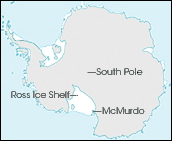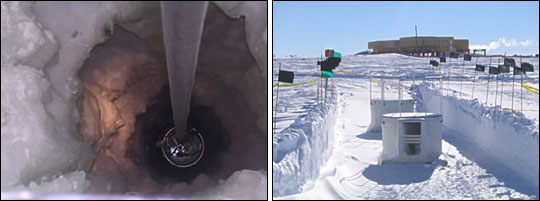

Beating a Path to the Pole | |||
The Antarctic traverse team was on its way to South Pole Station in a proof-of-concept trek from McMurdo Station. The National Science Foundation (NSF), which operates both stations, commissioned the traverse, and Bindschadler had worked on NSF-funded projects in the past. “It costs a lot to support people at the South Pole. The primary cost is just the fuel to keep them warm,” says Bindschadler. Ships regularly supply McMurdo on Antarctica’s coast with fuel. “But the last, most difficult part is getting the fuel from McMurdo to the South Pole,” he says. Historically, South Pole Station has been supplied by costly airplane flights. According to a report by the McMurdo Area Users Committee, aircraft used to transport fuel consume a gallon for every gallon they deliver. Added to the high fuel demand is the disadvantage that cargo transported south must fit into the airplanes’ fairly limited storage compartments. Large pieces of big telescopes, for instance, barely fit. “The South Pole has a 9,500-foot elevation, very low water vapor, and the cleanest air in the world,” says Blaisdell. “Because it’s at a pole, everything rotates around it. All those things make it an ideal place for astronomy.” Several types of telescopes operate at the pole, and construction is underway on a neutrino telescope that will be a cubic kilometer in volume. Transporting heavy materials for construction projects like this may be much easier on the ground than in the air. |

Reaching the South Pole from McMurdo Station, which lies along the coast of Antarctica, means negotiating challenging terrain on the Ross Ice Shelf and in the Transantarctic Mountains, which line the coast on the McMurdo side of the ice shelf. (Image adapted from CIA World Fact Book) | ||
 | |||
Another reason researchers wanted an overland—or oversnow—traverse was that airplanes in Antarctica are limited. Finding a different way to supply South Pole Station would free up flights to do other work. Once planners had settled on the concept of an oversnow traverse, they had to pick the best route. In 1958, Sir Edmund Hillary completed an adventurous motorized trek to the South Pole by driving up the Skelton Glacier near McMurdo. While Hillary’s route had its merits, especially the proximity to McMurdo Station if anyone ran into difficulty going up the glacier, researchers eventually settled on a different route. They chose to go across the Ross Ice Shelf to the base of the Leverett Glacier, up the Leverett, and across the Antarctic Plateau. |
In a mile-deep hole drilled in the ice by hot water jets, scientists have installed a piece of a new neutrino telescope at South Pole Station (left). Two tanks that are part of the neutrino telescope’s detector array sit on the ice surface (right). These and other large pieces of equipment may be more easily transported overland than by airplane in Antarctica. (Photos courtesy Berkeley Lab Research News) | ||
 | |||
One reason for this choice was vehicle performance. Reaching the Antarctic Plateau by crossing the Transantarctic Mountains at the start of the journey would force the vehicles to climb to the highest elevations carrying the most fuel. Once they are at the higher elevation, vehicles also operate less efficiently. By deferring the trip across the mountains until later in the journey, the traverse team could reduce the amount of fuel (and therefore, the weight) the vehicles had to carry up the mountains, and keep them running smoothly for a longer period. Bindschadler was one of the researchers the Antarctic Traverse planners had consulted for the best possible route, and he liked the Leverett Glacier. A small glacier not carrying much ice, it was less likely to hold many crevasses. It also had a low, gentle grade, making it easier for the team to climb. Though disconnected from the traverse project after helping choose the route, Bindschadler stayed interested in how his recommendation would work out. By the time Blaisdell called him in December 2004, it didn’t appear to be working out as well as he hoped. |
The Transantarctic Mountains roll into the distance. The Antarctic Traverse team followed a route that negotiated these rugged, high mountains later in their trip, when their vehicles were less weighed down with fuel. (Photo courtesy National Oceanic and Atmospheric Administration Photo Library) | ||